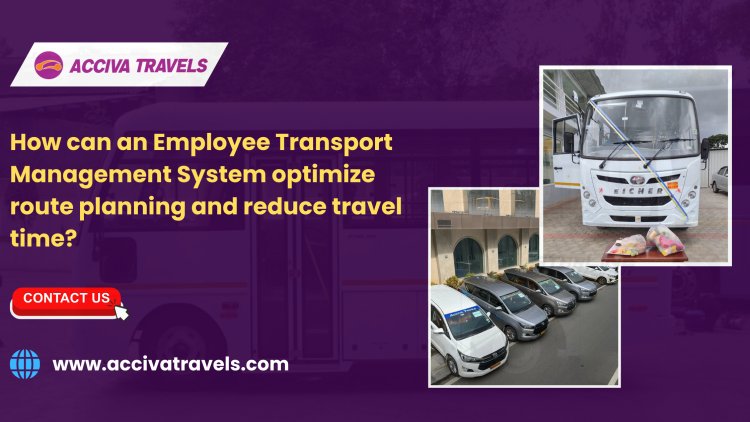How can an Employee Transport Management System optimize route planning and reduce travel time?
Effective transportation management is essential for maintaining productivity and employee satisfaction in today's fast-paced corporate environment.
Share this Post to earn Money ( Upto ₹100 per 1000 Views )
Introduction:
Effective transportation management is essential for maintaining productivity and employee satisfaction in today's fast-paced corporate environment. An Employee Transport Management System (ETMS) is a powerful tool designed to streamline and optimize route planning, significantly reducing travel time and enhancing operational efficiency. Here’s how an ETMS can revolutionize your organization’s transportation strategy.

Efficient Route Optimization:
One of the primary benefits of an ETMS is its ability to optimize routes. Traditional manual route planning is often inefficient and prone to errors, leading to longer travel times and increased fuel consumption. An ETMS utilizes advanced algorithms and real-time data to analyze traffic conditions, road closures, and other variables to determine the most efficient routes. By continuously updating routes based on current traffic conditions and historical data, an ETMS ensures that employees spend less time on the road and more time focusing on their work.
Real-Time Traffic Updates:
Traffic congestion can significantly impact travel times, leading to delays and frustration among employees. An ETMS integrates with real-time traffic monitoring systems to provide up-to-date information on road conditions, accidents, and congestion. This real-time data allows the system to dynamically adjust routes and provide alternative options, minimizing the impact of traffic-related delays. As a result, employees are less likely to encounter unexpected delays, leading to a smoother and more predictable commute.
Automated Scheduling and Dispatching:
Manual scheduling and dispatching can be time-consuming and error-prone. An ETMS automates these processes, ensuring that transport schedules are optimized based on various factors such as employee locations, preferred pick-up times, and vehicle availability. Automated scheduling reduces the likelihood of double-booking or scheduling conflicts, leading to more efficient use of resources and improved service quality. This not only saves time but also enhances overall operational efficiency.
Improved Vehicle Utilization:
An ETMS provides insights into vehicle utilization patterns, helping organizations to optimize the deployment of their fleet. By analyzing data on vehicle usage, such as the number of trips, distance traveled, and fuel consumption, the system can identify opportunities for improving vehicle allocation and reducing idle time. Enhanced vehicle utilization leads to cost savings on fuel and maintenance, and ensures that resources are used more effectively, contributing to overall operational efficiency.
Predictive Analytics for Better Planning:
Predictive analytics is a key feature of modern ETMS platforms. By analyzing historical data and trends, an ETMS can forecast future transportation needs and identify potential issues before they arise. For example, if the system detects a recurring pattern of delays in a particular route or period, it can suggest adjustments to schedules or routes to address these issues proactively. This proactive approach to planning helps to minimize disruptions and ensures that transportation operations run smoothly.
Improved Communication and Transparency:
An ETMS enhances communication between employees, drivers, and transport managers. Employees can receive real-time updates on their transportation status, including estimated pick-up times and route changes. Drivers can access detailed route information and receive notifications about any changes or updates. This improved communication helps to manage expectations and reduce confusion, leading to a more organized and efficient transportation process.
Customizable Reporting and Analytics:
An ETMS offers customizable reporting and analytics features that provide valuable insights into transportation operations. Organizations can generate reports on various metrics such as travel times, route efficiency, fuel consumption, and employee satisfaction. These insights help managers to identify areas for improvement and make data-driven decisions to optimize transportation strategies. By leveraging these reports, organizations can continuously refine their approach to route planning and travel time reduction.
Improved Employee Satisfaction:
Reducing travel time and improving the efficiency of employee transportation can have a significant impact on employee satisfaction. Long commutes and unpredictable travel times can lead to increased stress and decreased job satisfaction. By implementing an ETMS to optimize routes and reduce travel times, organizations can enhance the overall employee experience, leading to higher morale and increased productivity.
Cost Savings:
An optimized transportation system can lead to significant cost savings for organizations. By reducing travel times and improving vehicle utilization, organizations can lower fuel consumption, maintenance costs, and overtime expenses. Additionally, efficient route planning can help to minimize the environmental impact of transportation operations, contributing to sustainability goals and potentially reducing costs associated with emissions and environmental compliance.
Scalability and Flexibility:
As organizations grow, their transportation needs evolve. An ETMS is designed to scale with the organization, accommodating changes in the size of the fleet, the number of employees, and the complexity of routes. The system’s flexibility allows for easy adjustments to accommodate new routes, destinations, and scheduling requirements. This scalability ensures that the transportation management system remains effective and relevant as the organization’s needs change.
Conclusion:
An Employee Transport Management System can benefit your organization from improved route planning and reduced travel times to improved employee satisfaction and cost savings. By leveraging advanced technology and data-driven insights, an ETMS enhances operational efficiency, streamlines processes, and contributes to a more productive and positive work environment. As organizations continue to prioritize efficiency and employee well-being, an ETMS proves to be a valuable investment for achieving these goals.

 accivatravels
accivatravels 














